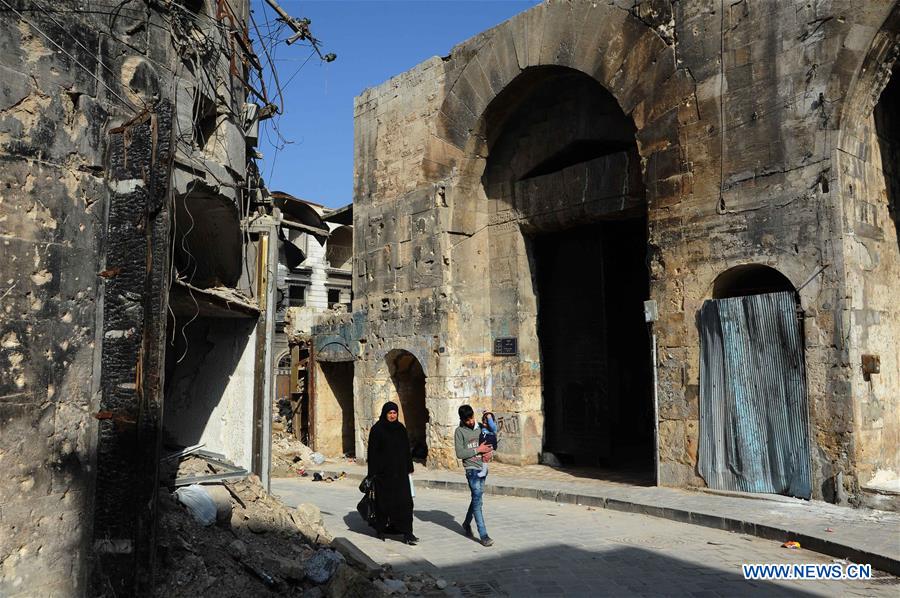 ?
?People walk past Bab al-Nasr Gate in the old city of Aleppo, Syria, on Feb. 6, 2018. War destroys people and homes in Syria, but amid the destruction, some old secrets get revealed. After the war, restoration efforts have started in the affected ancient sites in Aleppo. When volunteers started their work in Bab al-Nasr Gate, the layers which were added onto the stone ground and walls were cracked and in some parts destroyed, revealing the original structure and architecture of the gate and its exterior part. (Xinhua/Ammar Safarjalani)
by Hummam Sheikh Ali
ALEPPO, Syria, Feb. 6 (Xinhua) -- War destroys people and homes in Syria, but amid the destruction, some old secrets get revealed.
In the ancient part of Aleppo city in northern Syria, with the layer of modernity in some old buildings falling down, historic secrets started revealing themselves for the first time in hundreds of years.
When the war started raging in Aleppo, once the economic powerhouse of Syria, old marketplaces have been burnt and destroyed and the ancient gates at the walls of the old city have also sustained a great amount of destruction.
Bab al-Nasr, or the Gate of Victory, was among the ancient sites that have taken a strong beating during the war when the rebels were controlling that part of the city before they were dislodged in December 2016.
The Gate of Victory was built in 1212 and has become the most important gate guarding the northern walls of the old city of Aleppo, which has nine historic gates.
After the war, restoration efforts have started in old Aleppo, in some cases by volunteers who devoted their time and money to salvaging the heritage of their city.
Those who have worked to fix and restore the destroyed parts of the Gate of Victory called themselves the "Friends of Bab al-Nasr."
When they started their work, the layers which were added onto the stone ground and walls were cracked and in some parts destroyed, revealing the original structure and architecture of the gate and its exterior part.
The revealed parts included a holy shrine and a "defensive tower," which was used in times of war to defend the ancient city from foreign invaders.
As the additional layers and paintings on the original walls started falling out, workers at the site started peeling off the layers from the ground and walls completely and discovered holes in the walls that used to be a part of the gates' locks. The locks were deemed being used with a long wooden bar to completely seal the gate.
They also discovered a sort of a tunnel dug just behind the gate but did not find out what it was used for, as it was not mentioned in any historical literature.
The most important discovery, however, was a two-layer staircase hidden behind a wall leading to the rooftop of the gate's small compound.
Ala Sayyed, a historical researcher and an active member of the Friends of Bab al-Nasr, told Xinhua that their discovery would be an important addition to the history books.
"During the restoration process, the staircase was covered by a wall here. But as cracks started appearing on the wall, dust started falling out of the cracks, the wall started to fall out and we discovered a hole that was closed for hundreds of years leading to a historic staircase from the original structure of the building which was completely concealed and dates back to 800 years ago," he said.
This staircase leads to the rooftop of the defensive tower of the al-Nasr Gate, which otherwise could be accessible from outside the nearby buildings.
He said the discovery made them feel overwhelmingly happy and that their efforts have paid off finally.
"In fact when we discovered and entered it we were overwhelmed because it was a sealed place for hundreds of years and we were the first to enter it," he said
Calling it the "gate of secrets," Sayyed said he believed that the more work they do inside the old walls, the more they will discover.
He noted that some of the discoveries they have found are yet to be explained, such as old scripts on one of the walls inside the gate. They were for a man and a woman and near the names were palm prints.
He said the names were believed to be written at the times of the Greeks but their story is not known yet, as they could be lovers or a couple.
On the same wall, some holes in the size of hand fingers were found when the additional layer was removed. They appeared to be of those in the old times who believed in the stone's ability of healing certain illnesses.
Sayyed said the restoration process enabled them to discover the hidden staircase and other "mysterious" stuff inside the gate's interior.
"In fact, if it was not for tough conditions that Aleppo had gone through, and the damage done to this ancient gate and the restoration process that has ensued, we may have never had the chance to make this discovery," he said.















